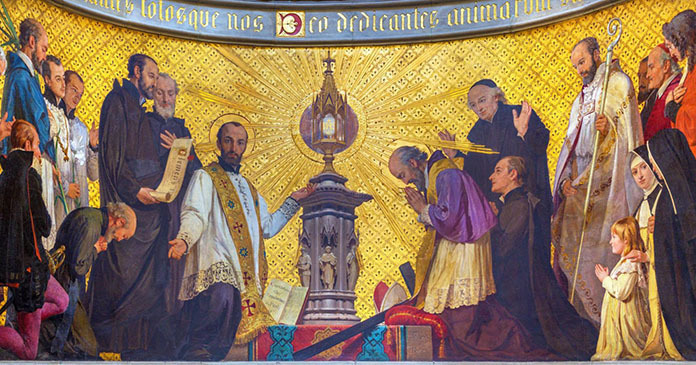
TURIN, ITALY – MARCH 15, 2017: The symbolic fresco of The adoration of Holys in front of Eucharist in church Chiesa di San Dalmazzo by Enrico Reffo (1831-1917).
As Covid restrictions lifted, and as bishops revoked the dispensation to attend Mass in person, who actually returned? So many faithful Catholics have been watching Mass streaming online, and not necessarily from their home parishes. Why watch at your home parish when you can watch a Mass from anywhere in the world, from the most beautiful churches, from the priests who give the best homilies, from churches with the best small choirs? In short, people may have been missing the real Eucharist, but they have become accustomed to beautiful liturgies.
As bishops write letters, ending the dispensation, some are finally teaching and holding over our heads the fact that missing Mass is a grave sin, and how the Eucharist is the source and summit of our faith.
I’ll say it again: The Eucharist is the source and summit of our faith. And that should be enough, say the people who call people like me liturgical fuss budgets. People like me who wish the lector would be prepared and know how to pronounce the words they read, who wish the priest would read the black and do the red, who wish the music didn’t make us feel like we were at a beach party drinking margaritas. People like me who wish the ugly art was gone, and the entire liturgy wasn’t an insult to our intelligence.
Well, we had a glimpse of what the Eucharist, source and summit of our faith was like without the liturgy. While churches were closed, we experienced drive-thru Holy Communion one Sunday. We drove into the parking lot, where a man directed us to stay in our cars, keep our masks on, and head this way. The priest came to the driver’s and then passenger’s windows, saying simply “Hi,” and then, “The Body of Christ.” Before we could remove our masks and consume the sacred host, a woman appeared at the driver’s window offering us a bulletin, and then we had to drive out, making room for the next car.
While Jesus was present in the drive-thru in all his glory, body, soul, blood and divinity, the experience for us was all too similar to the one we had 10 minutes later at Taco Bell.
We are weak, we are distracted, we are stressed out, we are worried, and we are busy. Yes, the Eucharist is source and summit of our faith, but consider that we are receiving something that LOOKS like a cracker in our car in a parking lot, with all the reverence of going through a car wash. Lord, help my disbelief!
Hollywood knows how help us believe for a short time that we are not in our living rooms or a theater, or waiting for an hour at the DMV, but immersed in the story unfolding on the screen. What makes us suspend our disbelief? What moves us to feel strong emotions for something that we know isn’t real? Hollywood immerses us in the story with great writing, actors, cinematography, and sound tracks.
What happens in church to help us to believe something that IS real, that for a short time we are not sitting on a hard pew, but rather entering the gates of Jerusalem, present at the Last Supper, mourning below the cross on Calvary, rejoicing at the empty tomb, and sitting in our place at the heavenly banquet? If Hollywood can make us believe we are present in the action on screen, how can our liturgy help us believe we’re present in these sacred mysteries? How does our liturgy help us suspend our disbelief?
You can preach all you want about the Eucharist being the source and summit of our faith, but if the liturgy doesn’t immerse us in the sacred mysteries, our faith will be wanting. We want to believe, but every time the priest reads a boring homily, breaks from the persona Christi to make up his own text, every time an unprepared lector stumbles over the words, every time the music sounds like something we’d hear on a pop radio station, it shatters our suspension of disbelief. Liturgy is theater, and everything that breaks the fourth wall draws us back to earth, to our hard pew, to our worries, to our temporal problems, and to what’s for lunch.
We need the liturgy and the beauty that surrounds the Eucharist to help us believe. That’s why we have sacred architecture, sacred art, sacred music, the holy Scriptures, and exquisite prayers. The Lord is present in the Eucharist, whether or not I believe, whether or not I feel it. But I want to believe it, and I want to feel it. Don’t call me a liturgical fuss budget. Call me weak of faith. Beautiful and reverent liturgy shatters my unbelief. God doesn’t need our best in liturgy, but he wants it. He knows we need it. “The sabbath was made for man, and not man for the sabbath.” (Mark 2:27)
